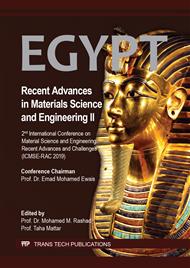[1]
I. Hod and A. Zaban, Materials and Interfaces in Quantum Dot Sensitized Solar Cells : Challenges , Advances and Prospects,, Langmuir vol. 30, pp.7264-7273, (2014).
DOI: 10.1021/la403768j
Google Scholar
[2]
K. E. Jasim, Dye Sensitized Solar Cells - Working Principles , Challenges and Opportunities,, In: Solar Cells-Dye-Sensitized Devices, Leonid A. Kosyachenko, (Ed),, Book Published by InTech Open Access Publisher, ISBN 978-953-307-735-2.. Chapter 8, pp.171-204, (2011).
DOI: 10.5772/19749
Google Scholar
[3]
J. M. L. Abhishek Swarnkar, Ashley R. Marshall, Erin M. Sanehira, Boris D. Chernomordik, David T. Moore, Jeffrey A. Christians, Tamoghna Chakrabarti, Quantum dot–induced phase stabilization ofa-CsPbI3 perovskite for high-efficiency photovoltaics,, sciencemag.org, vol. 354, no. 6308, p.92–96, (2016).
DOI: 10.1126/science.aag2700
Google Scholar
[4]
Q. M. Quanxin Zhang, Xiaozhi Guo, Xiaoming Huang, Shuqing Huang, Dongmei Li, Yanhong Luo, Qing Shen, Taro Toyoda, Highly efficient CdS/CdSe-sensitized solar cells controlled by the structural properties of compact porous TiO2 photoelectrodes,, Phys. Chem. Chem. Phy., vol. 13, no. 10, p.4659–4667, (2011).
DOI: 10.1039/c0cp02099k
Google Scholar
[5]
J. B. Mahmoud Samadpour, Pablo P. Boix, Sixto Gimenez, Azam Iraji Zad, Nima Taghavinia, Ivan Mora-Sero, Fluorine treatment of TiO2 for enhancing quantum dot sensitized solar cell performance,, J. Phys. Chem., vol. 115, no. 29, p.14400–14407, (2011).
DOI: 10.1021/jp202819y
Google Scholar
[6]
T.-K. Debasis Bera, L.Q., Tseng, Quantum dots and their multimodal applications: A review,, Materials (Basel)., vol. 3, no. 4, p.2260–2345, (2010).
Google Scholar
[7]
Y.F. NICOLAU, Solution deposition of thin solid compound films by a successive ionic-layer adsorption and reaction process,, Appl. Surf. Sci., vol. 22/23, no. PART 2, p.1061–1074, (1985).
DOI: 10.1016/0378-5963(85)90241-7
Google Scholar
[8]
M. K. N. H. LEE, M. WANG, P. CHEN, D. GAMELIN, S. ZAKEERUDDIN, M. GRÄTZEL, Efficient CdSe Quantum Dot-Sensitized Solar Cells Prepared by an Improved Successive Ionic Layer Adsorption and Reaction Process,, Nano Lett., vol. 9, no. 12, p.4221–4227, (2009).
DOI: 10.1021/nl902438d
Google Scholar
[9]
Q. W. Md. Anower Hossain, James Robert Jennings, Zhen Yu Koh, Carrier Generation and Collection in CdS/CdSe-Sensitized SnO2 Solar Cells Exhibiting Unprecedented Photocurrent Densities,,, ACS Nano, vol. 5, no. 4, p.3172–3181, (2011).
DOI: 10.1021/nn200315b
Google Scholar
[10]
Z. Abdel Hamid, H. B. Hassan, Manal A .Hassan, M. Hussien, S.Anwar, Effect of cadmium sulfide quantum dots prepared by chemical bath deposition technique on the performance of solar cell,, Egypt. J Chem., vol. 26, no. 9, pp.1575-1585, (2019).
DOI: 10.21608/ejchem.2019.6509.1547
Google Scholar
[11]
Y. Y. Wang M, Hua J, Fabrication of CDs/CdS-TiO2 ternary nano-composites for photocatalytic degradation of benzene and toluene under visible light irradiation,, Spectrochim. Acta Part A Mol. Biomol. Spectrosc., vol. 199, pp.102-109, (2018).
DOI: 10.1016/j.saa.2018.03.041
Google Scholar
[12]
Victor Y. Zenou, Microstructural analysis of undoped and moderately Sc-doped TiO2 anatase nanoparticles using Scherrer equation and Debye function analysis,, Mater. Charact., vol. 144, no. July, p.287–296, (2018).
DOI: 10.1016/j.matchar.2018.07.022
Google Scholar
[13]
Hyo Joong Lee, Multilayered semiconductor (CdS/CdSe/ZnS)-sensitized TiO2 mesoporous solar cells: All prepared by successive ionic layer adsorption and reaction processes,, Chem. Mater, vol. 22, no. 19, p.5636–5643, (2010).
DOI: 10.1021/cm102024s
Google Scholar
[14]
N. Qutub, S. Sabir, Optical, thermal and structural properties of CdS quantum dots synthesized by a simple chemical route,, Int. J. Nanosci. Nanotechnol., vol. 8, no. 2, p.111–120, (2012).
Google Scholar
[15]
S. A. Pawar, D. S. Patil, A. C. Lokhande, Myeng Gil Gang, J. Cheol Shin, P. S. Patil , J. Hyeok Kim, Chemical synthesis of CdS onto TiO2 nanorods for quantum dot sensitized solar cells", Optical Materials vol. 58, pp.46-50, (2016).
DOI: 10.1016/j.optmat.2016.05.019
Google Scholar
[16]
P.R. Deshmukh, U.M. Patil, K.V. Gurav, S.B. Kulkarni, C.D. Lokhande, Chemically deposited TiO2 /CdS bilayer system for photoelectrochemical properties,, Bull. Mater. Sci., vol. 35, no. 7, p.1181–1186, (2012).
DOI: 10.1007/s12034-012-0402-7
Google Scholar
[17]
B. Streetman and S. Banerjee, Solid State Electronic Devices: Prentice Hall, New Delhi- 110001, (2009).
Google Scholar
[18]
E. S. Nayereh Soltani, Elham Gharibshahi, Elias Saion, Band gap of cubic and hexagonal cds quantum dots-experimental and theoretical studies,, Chalcogenide Lett., vol. 9, no. 7, p.321–328, (2012).
Google Scholar
[19]
J. Wade, An investigation of TiO2-ZnFe2O4 nanocomposites for visible light photocatalysis,, A thesis Submitt. Partial fulfillment Requir. degree Master Sci. Electr. Eng. Dep. Electr. Eng. Coll. Eng. Univ. South Florida Major, (2005).
Google Scholar
[20]
Y. E. S. Moosakhani , A.A. Sabbagh Alvani , A.A. Sarabi , H. Sameie , R. Salimi , S. Kiani, Non-toxic silver iodide (AgI) quantum dots sensitized solar cells,, Mater. Res. Bull., vol. 60, p.38–45, (2014).
DOI: 10.1016/j.materresbull.2014.07.009
Google Scholar
[21]
Q. Zhang, Y. Zhang, S. Huang, X. Huang, Y. Luo, Q. Meng, D. Li, Application of carbon counterelectrode on CdS quantum dot-sensitized solar cells (QDSSCs),, Electrochem. commun., vol. 12, no. 2, p.327–330, (2010).
DOI: 10.1016/j.elecom.2009.12.032
Google Scholar


